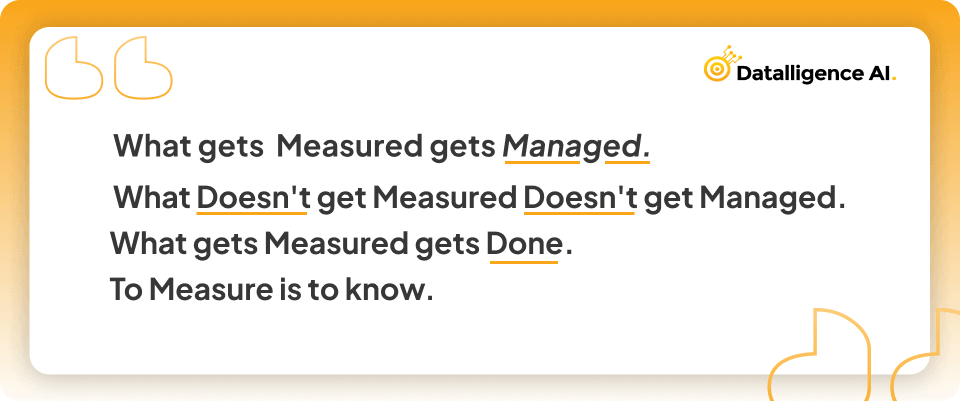Sales is the lifeblood of any business. It is the key driver for revenue generation, customer acquisition, and market expansion. Companies that excel at tracking and measuring their sales teams’ performance not only achieve their targets but often exceed them. According to a study by McKinsey, companies with a robust sales KPI measurement system are 20% more likely to be top performers in their industry.
The Importance of Tracking Sales Performance
Measuring your sales team’s performance is crucial for the following reasons:
Data-Driven Decision Making:
Without tracking, any business strategy is built on guesswork. Regularly measuring key sales metrics—such as conversion rates, average deal size, and time-to-close—provides actionable insights that help refine strategies.Goal Alignment:
Tracking progress toward sales targets ensures every team member is aligned with the company’s objectives. Organizations with clearly measured and tracked sales goals see 33% higher productivity, as reported by Salesforce.Identifying Strengths and Weaknesses:
By analyzing performance data, businesses can identify their top-performing products, services, and sales representatives. At the same time, they can pinpoint areas that need improvement—whether it’s sales pitch training or lead nurturing processes.
The Consequences of Not Measuring
A business without sales performance tracking is like driving a car with a blindfold on. You may have direction, but you have no visibility. Companies that fail to measure their sales output often struggle with stagnation, missed targets, and declining revenue. According to HubSpot, 74% of companies that don’t track their sales team’s activities miss their growth targets year after year.

One of the best ways to do this is by setting up key performance indicators (KPIs) that help you monitor the progress of your sales team and identify areas for improvement.
In this blog post, we will discuss the sales KPIs that you should be tracking to measure the performance of your sales team.
But first,
What is Sales KPI
A sales KPI (Key Performance Indicator) is a metric used to measure the performance of a sales team or individual salesperson. These metrics are typically used to track progress toward sales goals and targets, an ad can be used to identify areas for improvement.
Common examples of sales KPIs include:
- Sales revenue
- Number of new customers
- Sales conversion rate
- Average sale value
- Sales growth rate
- Number of sales per salesperson
- Sales cycle length
- Lead-to-customer conversion rate
- Sales forecast accuracy
Why are Sales KPIs so important:
Sales KPIs are used by sales teams and leaders to monitor their advancement toward objectives. Sales reps and managers might not be able to tell whether their efforts are yielding the expected results or whether the team must change course without knowing the sales KPIs. KPIs are also used to monitor new trends and themes.
Sales leaders can dig further to find root issues and how to address them based on the KPI. For instance, if sales of a new product exceed expectations, additional resources may be reallocated to the product’s marketing. On the other hand, the sales team may lower prices or focus their sales efforts on another product if a product is underperforming because of competitive pricing pressure.
What are the most important sales KPIs?

When it comes to sales, tracking key performance indicators (KPIs) is essential for understanding how your team is performing and identifying areas for improvement. But with so many different metrics to choose from, it can be overwhelming to determine which KPIs are most important for your business.
Here are six of the most important sales KPIs to keep an eye on:
1. Sales Revenue: This is the most basic and essential KPI for any sales team. It measures the total amount of money generated from sales. This metric can help businesses identify trends and forecast future revenue.
How to calculate it: Number of units sold x Average price per unit
2. Close rate: This metric measures the percentage of leads that are converted into paying customers. A high close rate indicates that your sales team is effective at nurturing leads and closing deals. A low close rate, on the other hand, may indicate that there are issues with the sales process or that leads are not being qualified properly.
How to calculate it: (Conversions / Total Leads) x 100.
3. Average deal size: This metric measures the average amount of revenue generated per sale. A high average deal size can indicate that your sales team is selling high-value products or services, while a low average deal size may indicate that your team is focusing on lower-value deals.
How to calculate it:(total value of closed won opportunities/ total number of opportunities)
4. Lead conversion rate: This metric measures the percentage of leads that are converted into opportunities. A high lead conversion rate indicates that your sales team is effectively qualifying leads, while a low lead conversion rate may indicate that leads are being wasted.
How to calculate it: (Number of new customers / total number of leads received)
5. Sales pipeline: This metric measures the number of leads, opportunities, and deals in various stages of the sales process. Tracking the sales pipeline can give you a sense of how many leads are being generated and how effectively they are being converted into paying customers.
How to calculate: (number of leads who moved to next stage) / ( total starting number of leads) = conversion rate
6. Customer Retention Rate: This KPI measures the percentage of customers that return to make additional purchases. A high customer retention rate can indicate that the sales team is providing excellent customer service and building long-term relationships with customers.
How to calculate: (Overall number of customers at the end of the year – net new customers acquired during the year) / (number of customers at the start of the year) x 100 = Customer retention
Tracking Sales KPIs with Software:
Tracking sales KPIs with OKR software which can help businesses stay on top of their sales goals and progress. By setting measurable objectives and key results, businesses can better understand their performance and make data-driven decisions to improve their sales strategies.
One of the key benefits of using OKR software for sales tracking is the ability to set and track progress on specific, measurable objectives.
For example, A business might set an objective of increasing sales revenue by 10% over the next quarter. The key results associated with this objective might include increasing the number of new customers by 5%, increasing the average order value by 3%, and reducing the number of sales returns by 2%.
In addition to providing data on key metrics, OKR software can also help you manage your sales team. For example, you can use the software to set targets for individual team members, assign tasks and responsibilities, and track progress toward goals. This can help you ensure that your team is working efficiently and effectively and can help you identify areas where additional training or resources may be needed.
Overall, OKR software is a powerful goal setting tool that can help you improve your sales performance by providing you with real-time data on key metrics, setting specific, measurable goals, and managing your sales team. By using this software, you can stay competitive and grow your business.
OKR Examples for Sales
Objective 1: Increase sales revenue by 15% within the next quarter.
- KR:1 Increase the number of new customer acquisitions by 20% within the next quarter.
- KR 2: Increase the average transaction value by 10% within the next quarter.
- KR 3: Increase the sales conversion rate from leads to customers by 5% within the next quarter.
Objective 2: Improve customer retention and loyalty.
- KR 1: Reduce customer churn rate by 15% within the next quarter.
- KR 2: Increase the number of repeat customers by 10% within the next quarter.
- KR 3: Increase customer satisfaction scores by 20% within the next quarter.
Objective 3: Expand into new markets
- KR 1: Identity and research 3 new market opportunities within the next quarter.
- KR 2: Establish a presence in at least 1 new market within the next quarter.
- KR 3: Generate at least $50,000 in sales from new markets within the next quarter.
Visit our 10 Best Sales OKR examples for more OKR examples in sales.
Conclusion:
There’s no shortage of sales KPIs to track — but zeroing in on the right ones depends on what’s important to your business right now. Using OKRs software to track your sales KPI would become easier and more efficient. Talk to our experts and coaches and gain more insights or Try Datalligence for “free”.











